|
|
|
Sort Order |
|
|
|
Items / Page
|
|
|
|
|
|
|
| Srl | Item |
| 1 |
ID:
137680


|
|
|
|
|
| Summary/Abstract |
This study evaluates scenarios for the oil production in Peru applying a Hubbert model. Two scenarios for the estimated ultimate recovery (EUR) were proposed: the first, in which low investments in E&P and social and environmental barriers undermine the development of oil resources beyond the limits characterized as 2P; the second, more optimistic, in which current exploratory and production areas in Amazonia and low-explored Offshore-Shelf basins are developed, thus, increasing EUR to 3P reserves plus contingent resources. Findings show that oil production in Peru has not followed a Single-Hubbert pattern, except for the area with more drilling activity and the highest accumulated production in the Northwest coast. Actually, institutional and regulation changes and less-attractive periods for operators due to poor results in oil discoveries explain why a multi-Hubbert approach better depicted the oil production in Peru. Peru has the potential to achieve a second peak of 274 kbpd of crude oil, overcoming the peak of 195 kbpd, reached in 1982. However, most of the remaining production would be located in Amazonia, where social and environmental issues pose critical challenges.
|
|
|
|
|
|
|
|
|
|
|
|
|
|
|
|
| 2 |
ID:
127283
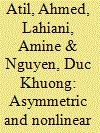

|
|
|
|
|
| Publication |
2014.
|
| Summary/Abstract |
In this article, we use the recently developed nonlinear autoregressive distributed lags (NARDL) model to examine the pass-through of crude oil prices into gasoline and natural gas prices. Our approach allows us to simultaneously test the short- and long-run nonlinearities through positive and negative partial sum decompositions of the predetermined explanatory variables. It also offers the possibility to quantify the respective responses of gasoline and natural gas prices to positive and negative oil price shocks from the asymmetric dynamic multipliers. The obtained results indicate that oil prices affect gasoline prices and natural gas prices in an asymmetric and nonlinear manner, but the price transmission mechanism is not the same. Important policy implications can be learned from the empirical findings.
|
|
|
|
|
|
|
|
|
|
|
|
|
|
|
|
| 3 |
ID:
127302
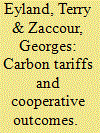

|
|
|
|
|
| Publication |
2014.
|
| Summary/Abstract |
In the absence of an international environmental agreement (IEA) on climate change, a country may be reluctant to unilaterally implement environmental actions, as this may lead to the relocation of firms to other, lax-on-pollution countries. To avoid this problem, while still taking care of the environment, a country may impose a carbon tariff that adjusts for the differences between its own carbon tax and the other country's tax. We consider two countries with a representative firm in each one, and characterize and contrast the equilibrium strategies and outcomes in three scenarios. In the first (benchmark) scenario, in a first stage the regulators in the two countries determine the carbon taxes noncooperatively, and in a second stage, the firms compete à la Cournot. In the second scenario, the regulators cooperate in determining the carbon taxes, while the firms still play a noncooperative Cournot game. In the third scenario, we add another player, e.g., the World Trade Organization, which announced a border tax in a prior stage; the game is then played as in the first scenario. Our two major results are (i) a border-tax adjustment (BTA) mimics quite well the cooperative solution in setting the carbon taxes as in scenario two. This means that a BTA may be a way around the lack of enthusiasm for an IEA. (ii) All of our simulations show that a partial correction of the difference in taxes is sufficient to maximize total welfare. In short, the conclusion is that a BTA may be used as a credible threat to achieve an outcome that is very close to the cooperative outcome.
|
|
|
|
|
|
|
|
|
|
|
|
|
|
|
|
| 4 |
ID:
127299
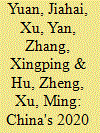

|
|
|
|
|
| Publication |
2014.
|
| Summary/Abstract |
China has proposed its 2020 clean energy target together with the climate change target of reducing CO2 intensity of the economy by 40-45% below the 2005 level. This article investigates the feasibility of these targets by testing their consistency under possible economic development scenarios. We analyse these targets from two perspectives: consistency with the overall economic growth and consistency with the international society's expectation on China's greenhouse gas (GHG) abatement responsibilities. The main findings are: under the recently announced 2020 target of gross domestic product (GDP) that is double the 2010 level, the adoption of a 15% clean energy target could result in excessive primary energy demand; and then with 40-45% GDP CO2 intensity reduction, CO2 emissions in 2020 could substantially exceed the International Energy Agency (IEA) 450 ppm scenario for China. Thus we propose a 17% clean energy target that can reconcile the domestic plan with international expectation. Our article also outlines the pathways to realise clean energy development into 2020 and proposes policy recommendations.
|
|
|
|
|
|
|
|
|
|
|
|
|
|
|
|
| 5 |
ID:
127279
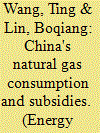

|
|
|
|
|
| Publication |
2014.
|
| Summary/Abstract |
China's natural gas consumption is growing rapidly and it has being driven by economic growth, industrialization and urbanization. In addition, the country's low-carbon development strategy, government-controlled gas price, and some other factors also contribute to the surging gas consumption. This paper studies China's natural gas consumption in residential, industrial and commercial sectors. We adopt the cointegration test and error correction model to study the relationships of explanatory factors and gas consumption of different sectors and climate factor is included into the analysis. In order to find the direction of natural gas pricing reform and establish the benchmark gas price, this paper also estimates the size of gas price subsidy by using price-gap approach. Our findings are as follows: In the long term, China's residential sector is more sensitive to price than the other two. Urbanization is an important factor promoting industrial and commercial gas consumption. Prices of other energies have an influence on natural gas consumption significantly due to the substitutability between energies. The slow-moving and unsatisfying pricing reforms on refined oil and natural gas lead to positive price elasticity of natural gas in the commercial sector, which implies that a further energy price reform is still stringent for China.
|
|
|
|
|
|
|
|
|
|
|
|
|
|
|
|
| 6 |
ID:
127295


|
|
|
|
|
| Publication |
2014.
|
| Summary/Abstract |
Sovereign Wealth Funds (SWFs) are state-owned investment funds that invest in real and financial assets. Since the global financial crisis in 2008, SWFs' investments have resulted in national security concerns of host countries because SWFs continue to expand rapidly and have become increasingly active in real-time strategic transactions. Given this background, China, which has the biggest SWF in the world, is facing severe challenges of energy resources shortages while its plan is to accomplish social and economic development goals. Energy security is a key driving force of the energy investment policy of China's SWFs. This makes the SWF investments more complicated and more politically sensitive. The combination of sovereign rights and the strategic importance of energy also makes geopolitics more complicated and brings more uncertainty to SWF investments. This article explores the relationship between energy security and energy investments of China's SWFs. It is recognised that the energy investment of SWFs must follow a sustainable path to coordinate energy security, economic growth, return on investment and national security concerns. Government policymakers are urged to balance the financial and political returns on SWFs against potential negative effects. The conclusion presents insights for policymakers, energy scholars and SWF researchers.
|
|
|
|
|
|
|
|
|
|
|
|
|
|
|
|
| 7 |
ID:
127301
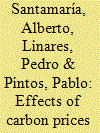

|
|
|
|
|
| Publication |
2014.
|
| Summary/Abstract |
This paper assesses the impacts on the cement, steel and oil refining sectors in Spain of the carbon prices derived from the European Emissions Trading Scheme (EU ETS), and the potential effect on these sectors of the European Union anti-leakage policy measures. The assessment is carried out by means of three engineering models developed for this purpose. Our results show a high exposure to leakage of cement in coastal regions; a smaller risk in the steel sector, and non-negligible risk of leakage for the oil refining sector when carbon allowance prices reach high levels. We also find that the risk of leakage could be better handled with other anti-leakage policies than those currently in place in the EU.
|
|
|
|
|
|
|
|
|
|
|
|
|
|
|
|
| 8 |
ID:
127291
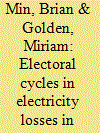

|
|
|
|
|
| Publication |
2014.
|
| Summary/Abstract |
A third of electricity in India is lost each year, where losses refer to power that is supplied but not billed. Utilizing data from the power corporation of Uttar Pradesh, India's most populous state, we study the politics of electricity losses. Examining annual data over four decades, we document that UP's electricity losses tend to increase in periods immediately prior to state assembly elections. Drawing upon geographically disaggregated data for the period 2000-09, we observe higher line losses just prior to the 2002 and 2007 state elections. Our analysis shows that the incumbent party was more likely to retain the assembly seat as line losses in the locality increased. We interpret these results as corroboration that political parties deliberately redirect electricity to flat rate and unbilled users in a context of chronically inadequate supply. Political factors appear to affect line losses in ways that technical and economic factors alone cannot explain.
|
|
|
|
|
|
|
|
|
|
|
|
|
|
|
|
| 9 |
ID:
087082


|
|
|
|
|
| Publication |
Toronto, Lexington Books, 1976.
|
| Description |
xii, 169p.
|
| Standard Number |
0669000485
|
|
|
|
|
|
|
|
|
|
|
|
Copies: C:1/I:0,R:0,Q:0
Circulation
| Accession# | Call# | Current Location | Status | Policy | Location |
| 015897 | 333.7/TIE 015897 | Main | On Shelf | General | |
|
|
|
|
| 10 |
ID:
127305


|
|
|
|
|
| Publication |
2014.
|
| Summary/Abstract |
The emergence of biofuel as a renewable energy source offers opportunities for significant climate change mitigation and greater energy independence to many countries. At the same time, biofuel represents the possibility of substitution between energy and food. For developing countries like India, which imports over 75% of its crude oil, fossil fuels pose two risks-global warming pollution and long-term risk that oil prices will undermine real living standards. This paper examines India's options for managing energy price risk in three ways: biofuel development, energy efficiency promotion, and food productivity improvements. Our salient results suggest that biodiesel shows promise as a transport fuel substitute that can be produced in ways that fully utilize marginal agricultural resources and hence promote rural livelihoods. First-generation bioethanol, by contrast, appears to have a limited ability to offset the impacts of oil price hikes. Combining the biodiesel expansion policy with energy efficiency improvements and food productivity increases proved to be a more effective strategy to enhance both energy and food security, help mitigate climate change, and cushion the economy against oil price shocks.
|
|
|
|
|
|
|
|
|
|
|
|
|
|
|
|
| 11 |
ID:
127304


|
|
|
|
|
| Publication |
2014.
|
| Summary/Abstract |
How would a low-carbon energy transformation affect energy security? This paper proposes a framework to evaluate energy security under long-term energy scenarios generated by integrated assessment models. Energy security is defined as low vulnerability of vital energy systems, delineated along geographic and sectoral boundaries. The proposed framework considers vulnerability as a combination of risks associated with inter-regional energy trade and resilience reflected in energy intensity and diversity of energy sources and technologies. We apply this framework to 43 scenarios generated by the MESSAGE model as part of the Global Energy Assessment, including one baseline scenario and 42 'low-carbon' scenarios where the global mean temperature increase is limited to 2°C over the pre-industrial level. By and large, low-carbon scenarios are associated with lower energy trade and higher diversity of energy options, especially in the transport sector. A few risks do emerge under low-carbon scenarios in the latter half of the century. They include potentially high trade in natural gas and hydrogen and low diversity of electricity sources. Trade is typically lower in scenarios which emphasize demand-side policies as well as non-tradable energy sources (nuclear and renewables) while diversity is higher in scenarios which limit the penetration of intermittent renewables.
|
|
|
|
|
|
|
|
|
|
|
|
|
|
|
|
| 12 |
ID:
127298


|
|
|
|
|
| Publication |
2014.
|
| Summary/Abstract |
Biodiesel production in Brazil has grown from 736 m3 in 2007 to 2.7 Mm3 in 2012. It is an emergent bioenergy for which it is important to guarantee environmental sustainability. The objective of this article is to characterise the biodiesel production chain in Brazil, to identify potential environmental impacts and to analyse key drivers and barriers for biodiesel environmental sustainability. This article explores these aspects and focusses on the increasing demand for the main feedstocks for biodiesel production in Brazil: soybean oil and beef tallow. The impacts of land use and land-use change on greenhouse gas emissions, biodiversity and water, as well as the energy balance, were found to be critical for the environmental sustainability assessment and development of biodiesel chains. Increasing agriculture yields, diversifying feedstocks and adopting ethyl transesterification can contribute to minimise environmental impacts. It was also found that environmental impacts could be mitigated by appropriate policies aiming at an integrated optimisation of food and bioenergy production and through agro-economic-ecological zoning, allowing adequate use of land for each purpose. Despite the limitation and weakness of some sustainability tools and initiatives, certification and zoning can play an important role in the sustainability of the emerging biodiesel production in Brazil.
|
|
|
|
|
|
|
|
|
|
|
|
|
|
|
|
| 13 |
ID:
175241
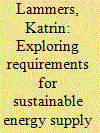

|
|
|
|
|
| Summary/Abstract |
Southeast Asia is one of the regions most affected by impacts of climate change underlying the urgency to build resilience especially for remote and isolated island communities. Moreover, these islands face the problem of expensive and unreliable electricity supply. The large number of island communities further magnifies the difficulty of reaching universal sustainable electricity supply. Off-grid electrification technologies promise to tackle this challenge entailing high investments yet also market potential. Currently both aspects – electricity access and climate resilience - are barely linked in electrification planning. Energy planning in a region highly affected by climate change requires integrative planning considering these risks. Here, to enhance integrative planning, we study the status quo of energy access and risk exposure of non-electrified Southeast Asian islands. We identify 1932 islands with a population greater than 21 million having limited access to electricity. Our study reveals three risk-specific island archetypes, which need different technical measures to enhance climate resiliency of future electricity systems. We conclude that future energy planning in Southeast Asia requires climate resilience as an additional planning dimension. The identified cluster groups serve as a blueprint for decision makers to support measures improving energy systems’ resilience avoiding expensive re-investments in the future.
|
|
|
|
|
|
|
|
|
|
|
|
|
|
|
|
| 14 |
ID:
127280


|
|
Financial analysis on the proposed renewable heat incentive for: a case study on the solar thermal system
/ Bakar, Siti Hawa Abu; Sukki, Firdaus Muhammad; Iniguez, Roberto Ramirez; Munir, Abu Bakar, Yasin, Siti Hajar Mohd, Mallick, Tapas Kumar, McLennan, Campbell, Rahim, Ruzairi Abdul
|

|
|
|
|
| Publication |
2014.
|
| Summary/Abstract |
This short communication paper focuses on the renewable heat incentive (RHI) scheme in the United Kingdom (UK); and in particular, on its implication on domestic installations of solar thermal systems (STSs). First, a short review on the STS in the UK is provided. Then, a detailed description of the RHI is discussed. A financial analysis is presented afterwards, analysing the impact of the RHI scheme on the applicants, in terms of the net present value and the internal rate of return. From the financial analysis it has been found that the RHI scheme for domestic installations is only attractive if a longer period of RHI payment, i.e. 17 years, or a higher RHI rate i.e. £0.32 per kW h is implemented. The current proposal from the UK government is not financially viable, and as a result, it may hinder the penetration of domestic solar thermal systems in the residential sector in the UK.
|
|
|
|
|
|
|
|
|
|
|
|
|
|
|
|
| 15 |
ID:
127273


|
|
|
|
|
| Publication |
2014.
|
| Summary/Abstract |
As government and industry plan to reduce energy consumption in building stock, there is a need to forecast the uptake of retrofit packages across building stock over time. To address this challenge a diffusion model was set up and applied to office building stock across New South Wales (NSW) in Australia, accommodating a high spatial resolution and temporal capability for projecting uptake of technology packages characterised by multiple variables. Six retrofit packages were set up for the diffusion model, which ranged from inexpensive services and manuals through to mid-priced packages involving energy efficient T5 lighting and solar hot water through to expensive packages such as chilled beams and Solar PV. We evaluated the model using a base case and two policy programs, representing the Green Building Fund and Environmental Upgrade Agreements. These were recent incentive programs funded by the Australian government to accelerate the uptake of retrofit packages, by providing financial support to upfront expenditures and removing barriers to retrofit. By forecasting uptake of each retrofit package to 2032 under each program, we demonstrate how the model can be a valuable resource in tailoring expensive government programs and increasing their effectiveness.
|
|
|
|
|
|
|
|
|
|
|
|
|
|
|
|
| 16 |
ID:
171526
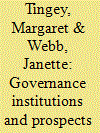

|
|
|
|
|
| Summary/Abstract |
UK Local Authorities are increasingly declaring ‘climate emergencies’ and pledging 100% clean energy and carbon neutrality ambitions for their locality, despite lack of powers over energy systems. Our research investigates current Local Authority engagement in clean energy, and considers prospects for meso-scale innovation. The analysis allocates Local Authorities to one of four categories of engagement, from energy ‘laggards’ through to ‘leaders’, based on their energy plans and investments. Findings reveal that, despite lack of direct powers, a high proportion of Local Authorities have developed sustainable energy plans and projects, but only a minority manage to combine these into a more strategic local programme. There was proportionately greater activity in Scotland and considerable variation was found across English regions. We conclude that variation in levels of engagement relates to authority size and divisions of responsibilities between different levels of government. The capacity for Local Authority-mediated social innovation to support development of a clean UK energy system is discussed. Implications for policy include the need for a statutory power, and commensurate resources, for Local Authorities, to ensure a more comprehensive and systematic contribution to clean energy innovation.
|
|
|
|
|
|
|
|
|
|
|
|
|
|
|
|
| 17 |
ID:
127267


|
|
Heat roadmap Europe: combining district heating with heat savings to decarbonise the EU energy system
/ Connolly, D; Lund, H; Mathiesen, B.V; Werner, S, Möller, B, Persson, U, Boermans, T, Trier, D, Ostergaard, PA, Nielsen, S
|

|
|
|
|
| Publication |
2014.
|
| Summary/Abstract |
Six different strategies have recently been proposed for the European Union (EU) energy system in the European Commission's report, Energy Roadmap 2050. The objective for these strategies is to identify how the EU can reach its target of an 80% reduction in annual greenhouse gas emissions in 2050 compared to 1990 levels. None of these scenarios involve the large-scale implementation of district heating, but instead they focus on the electrification of the heating sector (primarily using heat pumps) and/or the large-scale implementation of electricity and heat savings. In this paper, the potential for district heating in the EU between now and 2050 is identified, based on extensive and detailed mapping of the EU heat demand and various supply options. Subsequently, a new 'district heating plus heat savings' scenario is technically and economically assessed from an energy systems perspective. The results indicate that with district heating, the EU energy system will be able to achieve the same reductions in primary energy supply and carbon dioxide emissions as the existing alternatives proposed. However, with district heating these goals can be achieved at a lower cost, with heating and cooling costs reduced by approximately 15%.
|
|
|
|
|
|
|
|
|
|
|
|
|
|
|
|
| 18 |
ID:
104914
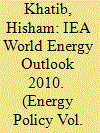

|
|
|
|
|
| Publication |
2011.
|
| Summary/Abstract |
The World Energy Outlook 2010 is a comprehensive energy report issued by the IEA. It is rewritten annually to reflect the world's changing energy and economy realities; it also introduces new issues relevant to the energy sector. This year it dealt with Caspian Energy, Energy Poverty and Energy Subsidies. WEO is controversial in few aspects; it still promotes a 450 Scenario which has become out of reach. This year however it introduced a more realistic New Policies Scenario which will need a lot of good will and investments to accomplish. Governmental policies are going to chart future energy sector performance; increasingly this is becoming decided by non-OECD countries. A more pragmatic future energy outlook is needed to reflect developing countries priorities for growth and utilization of local resources and how to accommodate this with abatement priorities through energy efficiency measures and technologies.
|
|
|
|
|
|
|
|
|
|
|
|
|
|
|
|
| 19 |
ID:
115173
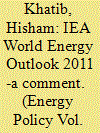

|
|
|
|
|
| Publication |
2012.
|
| Summary/Abstract |
There are increasing numbers of annual and periodical energy studies that look into future energy demand and sustainability issues. Among these the World Energy Outlook stands out as the most important futuristic energy study and analysis. The 2011 Outlook is in four parts and gives a full update of energy demand and supply projections to 2035. It analyses the possible evolution of energy markets under three scenarios. The core scenarios rest on common assumptions about macroeconomic conditions and population growth, while their assumptions about government policy differ. This year's Outlook offers an in-depth analysis of prospects for energy supply and use in Russia. It also provides an expanded assessment of the prospects for coal. It reviewed the future of nuclear energy after Fukushima, as well as the strategic challenges of energy poverty. Last it dealt with the important aspect of energy subsidies. In spite of its extensiveness and in depth analysis some of the Outlook assumptions and conclusions need careful analysis and review.
|
|
|
|
|
|
|
|
|
|
|
|
|
|
|
|
| 20 |
ID:
091584


|
|
|
|
|
| Publication |
2009.
|
| Summary/Abstract |
Infrastructure planning for networked infrastructure such as grid electrification (or piped supply of water) has historically been a process of outward network expansion, either by utilities in response to immediate economic opportunity, or in response to a government mandate or subsidy intended to catalyze economic growth. While significant progress has been made in access to grid electricity in Asia, where population densities are greater and rural areas tend to have nucleated settlements, access to grid electricity in Sub-Saharan Africa remains low; a problem generally ascribed to differences in settlement patterns. The discussion, however, has remained qualitative, and hence it has been difficult for planners to understand the differing costs of carrying out grid expansion in one region as opposed to another. This paper describes a methodology to estimate the cost of local-level distribution systems for a least-cost network, and to compute additional information of interest to policymakers, such as the marginal cost of connecting additional households to a grid as a function of the penetration rate. We present several large datasets of household locations developed from satellite imagery, and examine them with our methodology, providing insight into the relationship between settlement pattern and the cost of rural electrification.
|
|
|
|
|
|
|
|
|
|
|
|
|
|
|
|
|
|
|
|
|